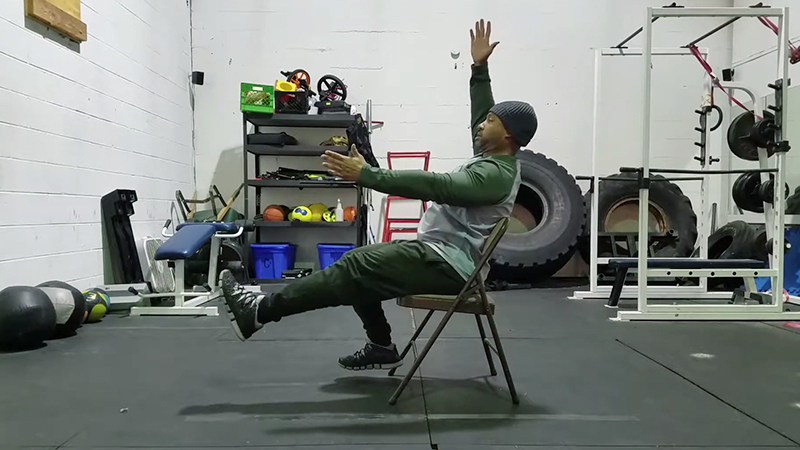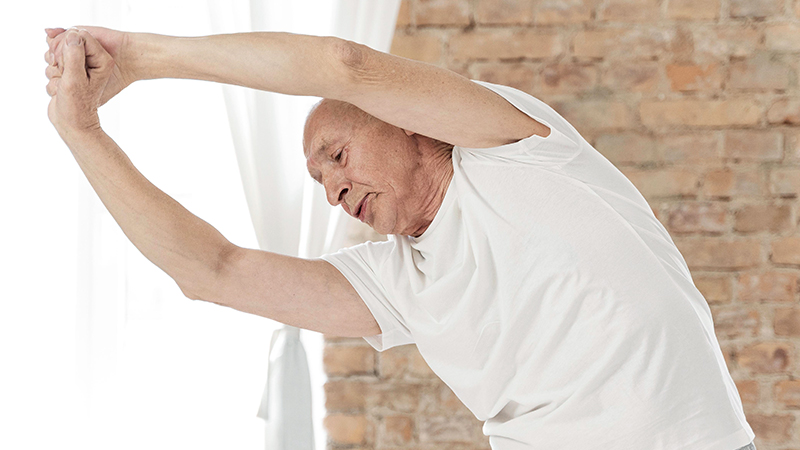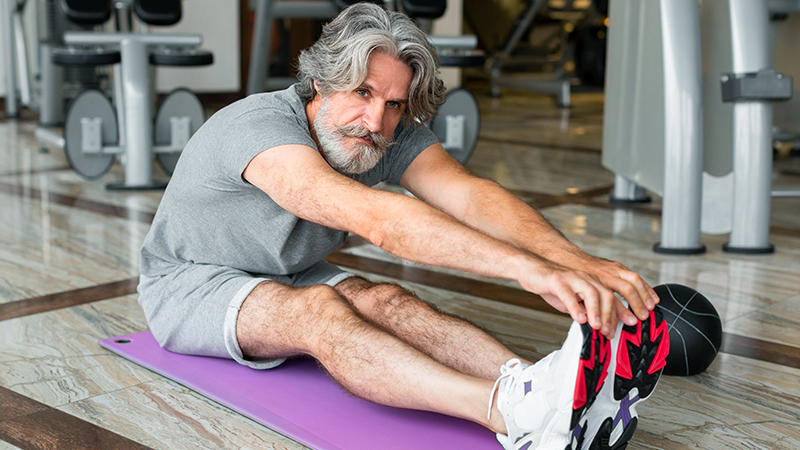Ever wondered why athletes and fitness enthusiasts swear by core workouts? It’s because a strong core isn’t just about having washboard abs.
It’s the sturdy foundation your body needs for better coordination, flexibility, and strength. And guess what? You don’t have to be a gym rat to develop a robust core.
As we age, maintaining our core strength becomes even more crucial. This article is here to guide you through ten of the best abdominal exercises tailored for seniors.
These workouts are not only efficient but also safe and easy to incorporate into your daily routine. So, let’s embrace a more active lifestyle and take the first step towards a stronger, more flexible you.

Evaluating the Proper Abdominal Exercises for Seniors
It’s essential that you understand how to choose the right exercises for your abdomen. Keep reading to learn about how to ensure your workouts are safe and effective.
Safe vs. Risky Core Exercises
Avoid high-risk exercises, particularly for the abdominal area, and instead opt for safe workouts that enhance core strength and stability.
Planks are a great example of such exercise, with a variation suitable for seniors involving minimal strain.
Key to this exercise is maintaining correct form with proper shoulder and wrist alignment. The routine involves performing the movement 10 times in three sets, with rest periods between each set.
Another low-impact but beneficial exercise is brisk walking which aids in calorie burn, weight loss and cardiovascular health.
It’s crucial to maintain proper body alignment during any workout: feet positioned behind your buttocks, knees bent at a right angle, and tailbone tucked under.
Abdominal Muscle Anatomy and its Significance
Understanding core muscles, particularly the transverse abdominals located deep within your trunk, can help in choosing effective abdominal exercises.
Exercises like planks strengthen these muscles, enhancing spine protection and stability and resisting age-related muscle mass loss.
It’s important to consider one’s physical capabilities when planning an exercise program, gradually increasing training intensity for improved core strength and ease in daily activities.
Top 10 Abdominal Exercises for Seniors
The following section outlines ten effective and safe abdominal exercises for seniors, designed to strengthen the core, improve balance, and enhance overall mobility.
1. Seated Dead Bug

Lie on your back with your knees bent over your hips, forming an upside-down L shape. Stretch one arm over your head and extend the opposite leg forward, keeping it off the floor.
Repeat the same movement on the other side, completing 10-12 reps per side. This is the Single Leg Stretch, ideal for seniors as it strengthens the core without straining the back.
It enhances balance and stability, essential for daily activities. Remember to maintain good form throughout the exercise for maximum benefit.
2. Seated Side Bends

While seated, place your feet flat on the floor, and extend your right hand overhead with your elbow lining up with your ear.
Breathe in, then as you exhale, lean to your left. Return to the original position and repeat the steps for your left side. Do as many repetitions as comfortable.
This seated side stretch exercise is great for seniors as it strengthens the oblique muscles, enhancing flexibility and balance.
It can be done in sets of 10-15 reps on each side, ensuring a balanced workout. Remember to maintain a steady breathing pattern throughout the exercise for optimal results.
3. Seated Forward Roll-Ups

Start seated with feet flat on the floor. Engage your core and roll your body down and up in a controlled motion. Your each roll-up should end with your back straight and chest lifted.
This is known as seated leg lifts, a perfect exercise for seniors as it strengthens the core and improves balance. Remember to breathe while executing this move and maintain proper posture throughout to avoid any strains or injuries.
4. Leg Lifts (Seated or Lying Down)

While seated, lift one leg and lower it down in a controlled manner. Focusing on leg-strengthening exercises is another significant way to improve lower body balance.
This form of seated leg lift not only strengthens the abdominal muscles, but also enhances hip flexibility and coordination.
Regular practice can contribute significantly to improved mobility and stability in seniors, reducing the risk of falls.
5. The Bridge

For the Bridge, lie on your back with your knees bent to 90 degrees, feet flat on the floor, and hip-width apart.
Lift your hips until your body forms a straight line from your shoulders to your knees, hold for a few seconds, then lower.
The Bridge strengthens the core, especially the lower back and hip muscles. It’s a perfect exercise for seniors as it not only boosts stability but also improves posture without straining the spine. Remember to breathe evenly throughout to maximize benefits.
6. Seated Half Roll-Backs

While seated, lean back halfway, keep your spine straight, and engage your core. Hold for a few seconds, then slowly return to the starting position.
This exercise, known as the seated core engagement, is ideal for seniors as it strengthens the abdominal muscles without placing undue strain on the back. Consistency with this routine can enhance balance and posture.
7. Wood Chops

Stand with your feet hip-width apart, bend sideways from your waist, keeping your torso straight. Raise your arms as if you’re holding an axe and bring them down diagonally across your body like you’re “chopping wood”.
Do 10 repetitions on each side. This is known as the “woodchopper” exercise. It helps to strengthen your core and improve flexibility, which can lead to better balance and stability.
Besides, it also works on oblique muscles, enhancing overall abdominal fitness for seniors.
8. Chair Planks

With a sturdy chair, step one foot at a time back until you’re in a plank position, shoulders above wrists. Make sure your shoulder blades are wide but not squeezed together.
Engage your abs and hold this position for 15-30 seconds, ensuring your body is aligned from head to heels. Repeat this exercise five times. This plank variation promotes core stability and strength, vital for seniors’ overall health.
9. Abdominal Bracing

Abdominal bracing can be done while standing or lying down. Simply tighten your abs as if you’re about to get punched in the stomach, hold for a few seconds, then release.
This exercise strengthens your core and improves balance, vital for seniors to prevent falls. It’s simple but effective, allowing you to engage all of your abdominal muscles without straining your back or neck.
10. Seated Knee Lifts

While sitting, lift one knee up towards your chest, then lower it back down. Repeat the move with the other leg. This exercise is great if you struggle with balancing on one foot.
Remember, regular workouts alongside a balanced diet are critical to maintaining good health in your senior years.
Incorporating exercises like seated leg lifts can be a safe and effective way for seniors to strengthen their abdominal muscles.
It’s low-impact, targets the core, and helps improve balance. For added benefits, consider integrating other exercises such as gentle yoga or Pilates into your routine.
How to Avoid Injuries while Performing Ab Exercises?
When it comes to fitness, especially for seniors, injury prevention is just as important as the workout itself. Let’s walk through some crucial factors to keep in mind.
Warm-up
Prior to starting your ab workout, it’s essential to warm up. This could involve light cardio like brisk walking or jogging on the spot. It helps prepare your body for the more strenuous activities ahead.
Listen to Your Body
It’s normal to feel a certain level of discomfort when exercising, but pain should never be ignored. If you feel any discomfort or pain, stop immediately and consult your doctor.
Stay Hydrated
Getting older also means your body doesn’t conserve water as well. Drinking water before, during, and after exercise can help reduce the risk of dehydration and subsequent injuries.
Know Your Limits
Fitness isn’t a race, but a life-long journey. Always stay within your limits and gradually increase intensity only when you’re comfortable.
Mind Your Posture
Incorrect posture can lead to injuries. For instance, while doing seated dead bug or leg lifts, keep your feet directly behind your butt and your knees bent to 90 degrees. Your hips might tend to push back, but it’s important to keep your tailbone tucked under.
Controlled Movement
When exercising, don’t rush the process. Proper form often involves slow, controlled movements that work your muscles better and reduce injury chances.
Use Equipment Properly
When using tools like resistance bands, ensure they’re used correctly. For example, keep your shoulders down and hold the band straight in front of you, activating your core.
Rest Time
Make sure to rest between sets. Completing three sets of 10 to 12 reps per side and resting for 60 to 90 seconds between sets can be a good routine.
Get Professional Guidance
Last but not the least, especially for beginners, getting guidance from an experienced trainer can help ensure exercises are done with proper form, reaping maximum benefits and avoiding injuries.
Frequently Asked Questions
How often should seniors do core exercises?
Seniors should regularly include core exercises in their weekly workout routine. The frequency will vary individually, but generally, core training should occur multiple times a week. Remember, diversify the exercises to target different muscle groups and keep the routine interesting.
How do core exercises help seniors avoid falls?
Core exercises help reduce the risk of falls in seniors. Regular workouts, particularly focusing on the core, promote stability and balance in the body. A strong core makes it harder for anything to cause imbalance, hence lowering fall risks.
Which muscles make up the core?
The core stretches from the lower rib cage to the buttocks. It encompasses abdominal muscles such as the rectus abdominis, external and internal obliques, and transversus abdominis. The erector spinae in the back and gluteal muscles in the buttocks are also components of the core.
Why is core strength important for seniors?
Core muscles extend from the lower head to the pelvis, supporting stability and balance. Strengthening these muscles reduces the risk of falls, which are common among seniors. Improved core strength helps quickly recover balance if destabilized.
Why should seniors strengthen their cores?
Enhanced core strength lowers the risk of falls, a leading cause of fatal injuries in seniors. It includes strengthening not just the “six-pack” muscles or rectus abdominus, but also the obliques, transversus abdominus, hips, and lower back – collectively providing overall torso strength.
Conclusion
You’ve now got the tools to start a safe and effective abdominal workout routine. Remember, it’s all about strengthening your core muscles, especially those transverse abdominals.
Start slow, be consistent, and gradually up your game. Warming up, staying hydrated, and knowing your limits are key to preventing injuries. Don’t forget the importance of proper posture and correct use of equipment.
Resting between sets is equally important, and never hesitate to seek professional advice. With these best abdominal exercises for seniors, you’re on your way to improved strength and flexibility. Here’s to a healthier, more active you!
I am a fitness instructor and I have been in the industry for 9 years. I have a passion for health and fitness.
I am a fitness instructor with over 9 years of experience in the industry. My passion is health and fitness and I would love to share my knowledge with you!